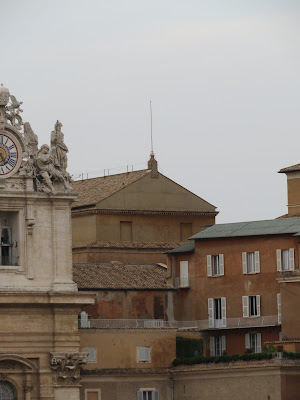The Chapel of Saint Catherine is located behind the Sacristy of the Basilica. The Sacristy itself is an amazing and historic space. It has housed at least two Papal Conclaves, those of 1431 and 1447, to elect Popes Eugene IV and Nicholas V respectively. It can be found behind a gate just to the left of the Gospel-side Transept of the Basilica but, as ever, our intrepid pilgrimages organizer obtained for us access to some of those places in Rome where very few and only seldom go. The decoration of the Sacristy is by Andrea Sacchi in 1600, including the Crucifixion in the niche at the far end of the Sacristy (behind which is the Chapel of Saint Catherine). The ceiling scene of St. Dominic in glory is attributed to Giuseppe Puglia. The fresco of the Roman painter G. B. Speranza is placed on the front door, dating from 1640, and represents two conclaves which took place here. The Barberini bees - a motif that will recur throughout our pilgrimage - appear in several places in the Sacristy. In this case, they are the emblem of Cardinal Antonio Barberini, Archbishop of Reims, known as Antonio the Younger, one of the Cardinals Nephew of Pope Urban VIII. The Barberini family was a great benefactor of the Dominican Order and funded the decoration of the sacristy. The vestment benches and presses are also 17th cent. and are of walnut.
Inside the Basilica of Santa Maria Sopra Minerva
The Basilica is too filled with historic and artistic gems to cover all but those that our group concentrated upon were the tomb of Saint Catherine of Siena under the High Altar (seen below with the tomb of Pope Clement VII Medici behind. Opposite it out of shot the tomb of Pope Leo X Medici, both Florentines with strong connections to the Dominican Order), next to it, the Capranica Family Chapel of the Holy Rosary, where we had Mass on a previous Pilgrimage, the Caraffa Family Chapel with the tomb of Pope Paul IV at the end of the Epistle-side Transept (opposite the Chapel of St. Dominic at the end of the Gospel-side Transept, built for Pope Benedict XIII, the Dominican Pope, and containing his tomb), and finally, just next to the Caraffa Chapel, the tomb of the redoubtable Durandus.
In the Piazza outside the Basilica is Bernini's famous Obelisk supported by an Elephant, erected here by Pope Alexander VII Chigi, the first member of the Sodality of Our Lady (of a total of 20) to be elected Pope and of whom we shall hear much throughout the pilgrimage. Opposite the Basilica is the Palace of the Pontifical Ecclesiastical Academy, or the Academy of Noble Ecclesiastics, the finishing school for Vatican diplomats.
Just around the corner is the discreet - but fascinating - shopfront of Ditta Annibale Gammarelli, Ecclesiastical tailors since 1798, who provided the vestments for our pilgrimage.
Just a few steps up the street is the Pontifical French Seminary and the Seminary Church of Santa Chiara. Across the tiny Piazza di Santa Chiara is the Palazzo di Santa Chiara. This was once a house of Dominican Tertiaries and the actual site of the death of Saint Catherine of Siena. As already mentioned, the room itself where she died was moved into place behind the Sacristy of the Minerva, and the space left by that removal has been replaced by an amazing little chapel of 'Santa Catarina in Transito' which remains open to the public despite the Palazzo now being a public theatre - where some of the pilgrims also attended a selection of operatic pieces one evening of the trip.















































